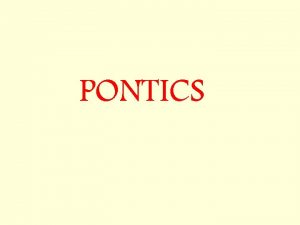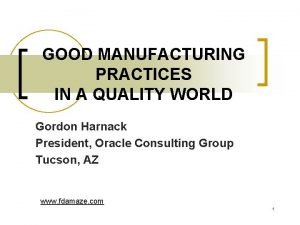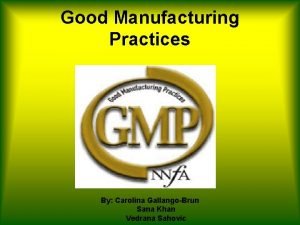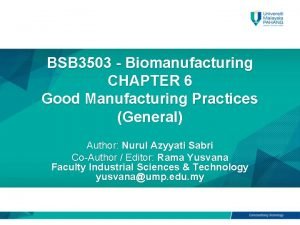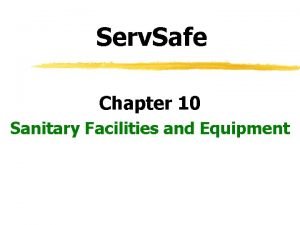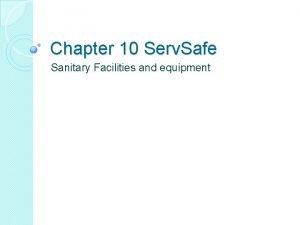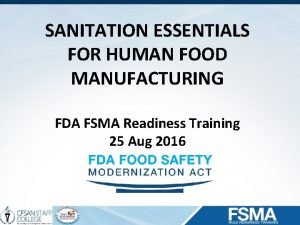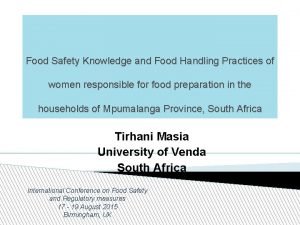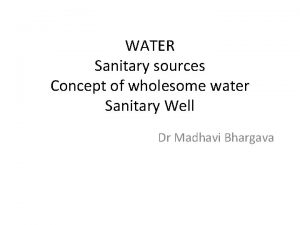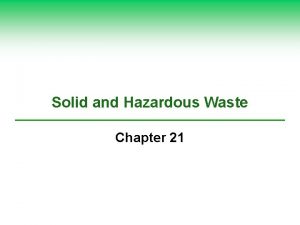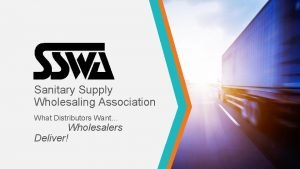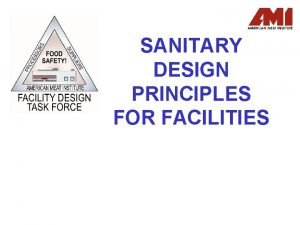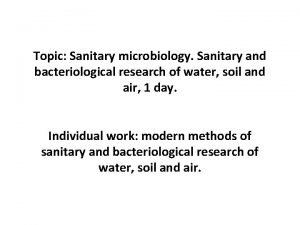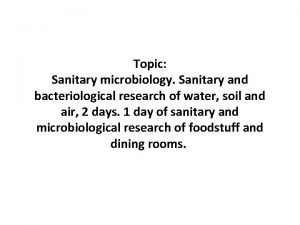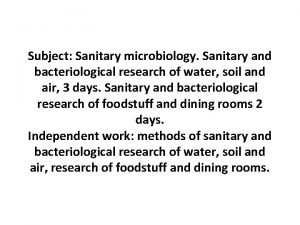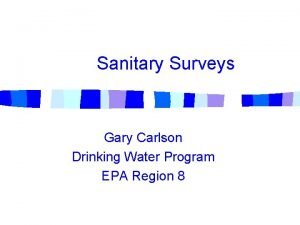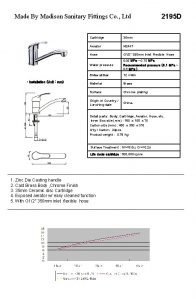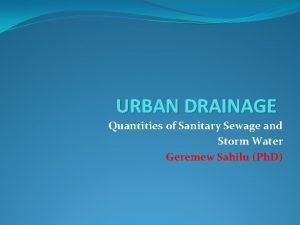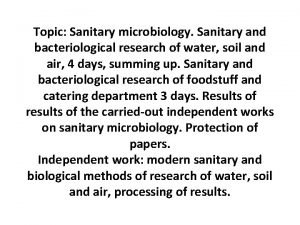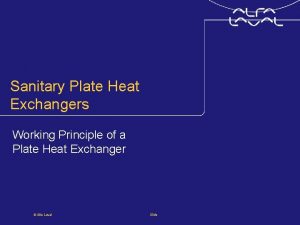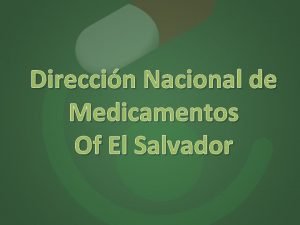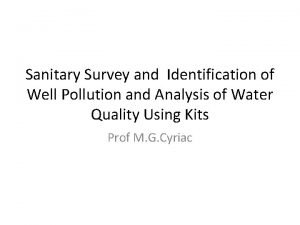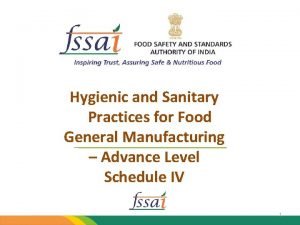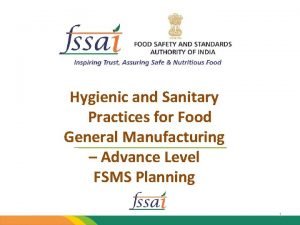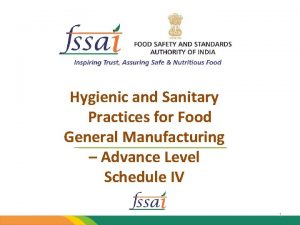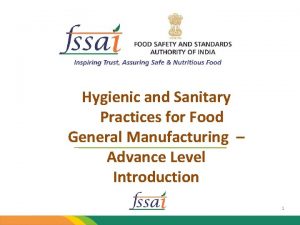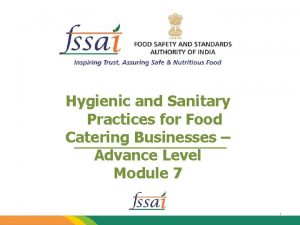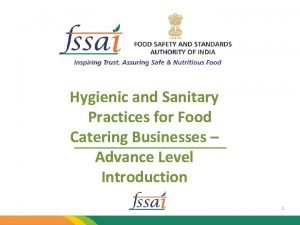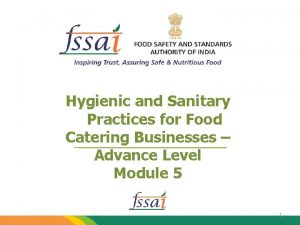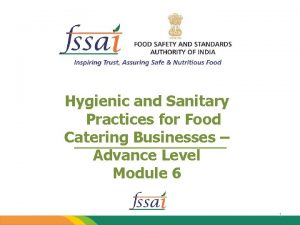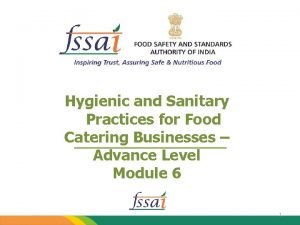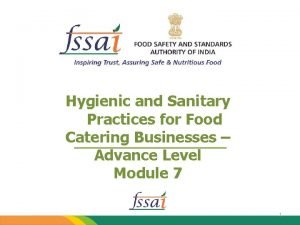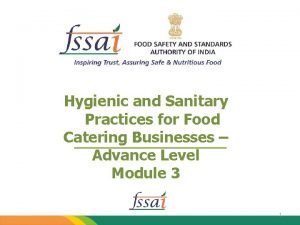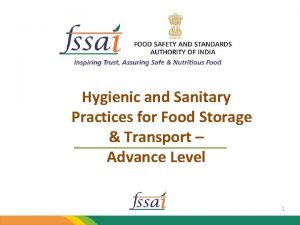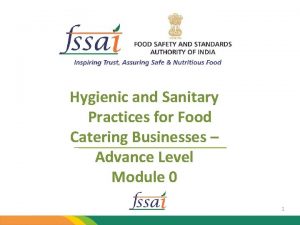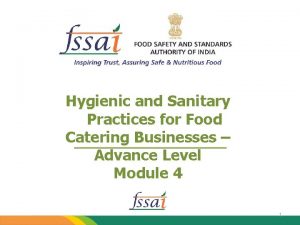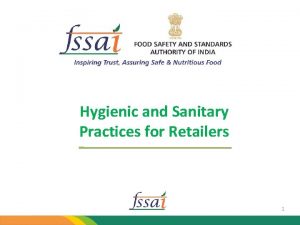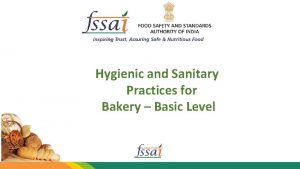Hygienic and Sanitary Practices for Food General Manufacturing




































- Slides: 36

Hygienic and Sanitary Practices for Food General Manufacturing – Advance Level Introduction 1

Introduction to Food Safety • Food Safety means assurance that food is acceptable for human consumption according to its intended use. • Food Safety Management System means the adoption Good Manufacturing Practices, Good Hygienic Practices, Hazard Analysis and Critical Control Point and such other practices as may be specified by regulation, for the food business. 2

What is FSMS as per FSSAI • FSS Act 2006 defines Food Safety Management System (FSMS) means the adoption Good Manufacturing Practices, Good Hygienic Practices, Hazard Analysis and Critical Control Point and such other practices as may be specified by regulation, for the food business. • For the purpose of this document and all assessments conducted there under, the definition of FSMS shall be read as the above and the requirements for this be taken as that defined under Schedule IV & Critical Control Point. 3

FSMS Program Based on FSSA Schedule 4 Compliance FSMS Plan FSMS Program 4

Schedule IV 1. Why? Section 16 of the FSSA, holds FSSAI responsible for regulating and monitoring the manufacture, processing, distribution, sale and import of food so as to ensure safe and wholesome food. 2. How? By introducing basic hygiene and safety requirements in the form of Schedule IV 3. Where in FSSR? The Schedule IV has been mandated for compliance by introducing it as a licensing requirement/condition under the Food Safety and Standards (Licensing and Registration of Food Businesses) Regulations, 2011. 5

Where does it impact? 1 • Filing Application 2 • Unique Application Number 3 • Providing Additional Requirement • Inspection of Premise 4 5 • Inspection Report 6 • Either grant or reject application 6

Non-conformance may lead to 1. Under FSS (Licensing and Registration of Food Businesses) a) Notice/ rejection of application during inspection for licensing b) Notice/cancellation of license during periodic food safety audit by the Licensing Authority 2. Under Section 56 of FSSA a) Penalty of up to Rs one lakh for unhygienic or unsanitary processing or manufacturing of food under 7

Introduction to Food Safety Hazard - biological, chemical or physical agent in food, or condition of food, with the potential to cause an adverse health effect. Physical Chemical Food Hazards Biological Allergens 8

Introduction to Food Safety Physical Hazards Any foreign object (inanimate) found in the food or a naturally occurring object (bone in fillet), that poses; a hazard is called a ‘Physical Contamination’. Common Physical Hazards include : Glass Chipped pieces of cutlery and crockery Metal shavings from cans and foils Stapler pins Blades Plastic films used for wrapping or chipped pieces of disposables Lint and threads Band- aids Hair Finger nails Bones Jewellery pieces 9

Introduction to Food Safety Chemical Hazards Naturally occurring and Process Induced Chemical substances that can cause a food borne illness is called a ‘Chemical Contaminant or Hazard’. Process Induced Chemical Contaminants include : - Toxic metals in the catering set up or supply chain - Pesticides, Colorants - Cleansing products and sanitizers - Equipment lubricants - Chemical Food Additives, Preservatives Natural Chemical Contaminants include : - Ciguatoxin , Saxitoxin, Brevitoxin and Domoic Acid from Marine Algae - Histamine / Scombroid poisoning from fish 10

Introduction to Food Safety Biological Hazards Biological hazards are organisms, or substances produced by organisms, that pose a threat to human health. They are a major concern in food processing because they cause most food borne illness outbreaks. Major biological hazards include – - Bacteria ex: Salmonella spp. , Enterohaemorrhagic Escherichia coli, Campylobacter jejuni, Yersinia enterocolitica, Listeria monocytogenes, Bacillus anthracis, Bacillus cereus, Staphlococcus aureus, Clostridium botulinum, Clostridium perfringens, Vibrio vulnificus, Vibrio parahaemolyticus - Virus ex: hepatitis A virus, Norwalk viruses, Rotavirus - Parasites ex: Toxoplasma gondii, Cryptosporidia, Giardia spp. , Trichinella spiralis, Taenia solium, Anisakis spp. 11

Introduction to Food Safety Biological Hazards causes 1. Food Borne Infections result when a person consumes food containing pathogens; which grow in the human intestine and cause discomfort or disease. Typical symptoms of a ‘food borne Infections’ do not appear immediately. 2. Food Borne Intoxications result when a person consumes food containing toxins in it; that cause discomfort or disease. Typical symptoms of a ‘food borne Intoxication’ appear quickly. Food Borne toxin – mediated infections result when a person consumes food containing toxins produced by the pathogens in it; which grow in the human intestine and produce toxins that cause discomfort or disease. 12

Introduction to Food Safety Conditions favouring growth of Microorganisms FAT TOM Conditions Definition Food borne Microorganisms draw nutrients from Potentially hazardous foods Acidity Food borne Microorganisms grow well between the p. H range of most foods Temperature Microorganisms grow well between the temperature range of 5⁰C – 60⁰C, most commonly known as the ‘Danger Zone’ Time Microorganisms need sufficient time to grow; when exposed to the ‘Danger Zone’ Oxygen Microorganisms require oxygen in free or combined state; to favor their growth Moisture Microorganisms require moisture to grow and is measured in the form of ‘Water Activity (Aw)’ 13

Introduction to Food Safety ACTIVITY- 1 1. Food Hazards can be present in food when reduced to an acceptable level. True/False 2. Equipment Lubricant is a a. Physical Hazard c. Biological Hazard b. d. Chemical Hazard Allergen 3. Microorganisms grow well between the temperature range of. . . . . , most commonly known as the ‘Danger Zone’. a. 7⁰C – 74⁰C b. 5⁰C – 74⁰C c. 5⁰C – 60⁰C d. 7⁰C – 60⁰C 4. Food Borne. . . result when a person consumes food containing pathogens. a. Infection b. Intoxication 5. Fish bone in a fish gravy dish is a physical hazard. True/False 14

Introduction to Food Safety ALLERGENS 15

Allergens Cereals containing gluten Sulphite in concentrations of 10 mg/kg or more Tree nuts and nut products Allergens Crustacea and products of these Eggs and egg products Milk and milk products Fish and fish products Peanuts, soybeans and products of these 16

Allergen Management Allergies, Allergens & Food Handlers 17 • What is the responsibility of a food company in Allergen Management? • What is the responsibility of the Food handler in Allergen Management? • What is the consumers responsibility in Allergen Management?

Foods Responsible for Allergic Reactions • • • Peanuts Tree Nuts Sesame Seeds Eggs Soybeans Milk Various grains and flours Fish Shellfish Sulphites (10 ppm) 18

Responsibility of a FBO in Allergen Management? • Provide safe, wholesome food to the marketplace. • Provide proper information with the product to allow the consumer to make an informed choice. 19

Provide Safe, Wholesome Food to the Marketplace. • • 20 Allergen policy and program Risk Assessment Formulation Control Ingredient Management Process Controls Packaging Management Label Control Employee Training

Allergen Program – Production – Expectation of program environment – Training – Responsibilities – Restriction of non approved ingredients – Consequences – Marketing program – Be aware of – Hygienic practices employees with food allergies W 5 & – Have a response program in place How 21

Provide Safe, Wholesome Food to the Marketplace. • Policy, GMP, SOP, Monitoring, Deviation Procedure and Verification must state W 5 & How 22 – Who – What – When – Where – Why – How

Formulation Control – No unapproved changes to formulation – Use only most recent approved formula – Follow SOP for scaling and use 23

Ingredient Management – Purchase only from approved suppliers – Purchase and use only approved ingredients – Store to prevent damage and cross contamination 24

Process Controls • • • 25 Sequencing Products Scaling (Scoop & Bins) Shielded lines Rework Label control Cleaning of equipment

Provide Proper Information with the Product Label • • • Ingredient list Instructions for use Warnings Information Contact 26

Provide Proper Information with the Product • Accurate labelling is required by regulation. • Label misrepresentation is fraud • Knowingly selling a product with an undeclared allergen can be interpreted as a criminal offense in case of illness or fraud. 27

Responsibilities of the Food Handler • Advise of formulation or process inefficiencies • Use only approved ingredients • Do not make decisions which can affect food integrity or safety unless empowered and trained to do so • Use product rework only in the product for which it was originally produced • Understand your responsibilities • Understand do the job as trained 28

Responsibilities of the Food Handler • Prepare foods which contain known allergens after all other products have been produced, follow sequence as directed. • Avoid cross-contamination • Wash hands thoroughly after handling known allergens • Wash hands thoroughly after eating 29

Responsibilities of the Food Handler • Keep aprons and clothing free of allergens • Follow a very thorough sanitation program to prevent cross-contamination. • Keep dust down • Keep all ingredients closed when not in use • Use only specified equipment and utensils 30

Consumers Responsibility • • 31 Report non conformities in labelling Educate family and Consumers Be aware of pitfalls Make educated decisions based on reliable information

Remember • • • 32 Don’t assume all people can eat all foods Do your job as trained Do not make decisions for the consumer Do no cross contaminate Properly label all foods

Be Concerned Be Allergy Aware. 33

Introduction to Food Safety ACTIVITY-2 1. Eggs and egg products are allergens. True/False 2. Allergens and non-allergen product can be prepared in same containers without cleaning. True/False 3. Store allergenic ingredients or products separately to prevent minimize. . . . a. Production b. Waste c. Cross-contamination d. Space 4. Which foods and ingredients are known to cause hypersensitivity and shall always be declared. a. Chicken b. Red Meat c. Rice d. Milk 5. . . . is a powerful chemical that can cause a reaction in the respiratory system, gastrointestinal tract, skin or cardiovascular system. a. Cystine b. Histamine c. Keratin d. Niacin 34

Introduction to Food Safety FOOD SPOILAGE 35

Introduction to Food Safety ACTIVITY- 3 1. Illness/injury to staff may lead to ……………. a. Food Spoilage b. Biological Hazard c. Allergens d. Cross-contamination. 2. ………………, right time, proper additives and understanding process steps is essential to ensure food safety. a. Wrong Temperature b. Cleaning of Utensils c. Allergens d. Right Temperature 3. ……………. , if not disposed in a scientific manner it can breed pest and micro organisms which is a threat to food safety. a. Physical hazard b. Chemical Hazard c. Waste d. Allergens 4. Right combination of time, temperature ventilation and segregation defines a good storage. True/False 5. Food zones must have ………………. humidity to ensure food safety. a. More than 80% b. Less than 65% c. More than 65% d. Less than 80% 36
 European hygienic engineering & design group
European hygienic engineering & design group Pontic dental definition
Pontic dental definition Saddle or ridge lap
Saddle or ridge lap Manufacturing cost vs non manufacturing cost
Manufacturing cost vs non manufacturing cost Job costing vs process costing examples
Job costing vs process costing examples Non controllable cost
Non controllable cost Manufacturing cost vs non manufacturing cost
Manufacturing cost vs non manufacturing cost Additively
Additively Gmp regulations
Gmp regulations Good manufacturing practices in pharmaceutical industry
Good manufacturing practices in pharmaceutical industry Gmp meaning
Gmp meaning Good manufacturing practices adalah
Good manufacturing practices adalah Pengertian gmp
Pengertian gmp In keeping equipment and facilities safe and sanitary
In keeping equipment and facilities safe and sanitary Unit 2 food food food
Unit 2 food food food Food chain food chain food chain
Food chain food chain food chain Sanitary facilities and equipment
Sanitary facilities and equipment What is visual pollution definition
What is visual pollution definition Master sanitation schedule
Master sanitation schedule Improper food handling practices
Improper food handling practices Parapet wall sanitary well diagram
Parapet wall sanitary well diagram Castelli sanitary
Castelli sanitary Sanitary landfill
Sanitary landfill Sanitary supplies wholesaler
Sanitary supplies wholesaler Sanitary equipment design principles
Sanitary equipment design principles Las gallinas valley sanitary district
Las gallinas valley sanitary district Sanitary microbiology
Sanitary microbiology Sanitary microbiology
Sanitary microbiology Sanitary microbiology
Sanitary microbiology Epa sanitary survey
Epa sanitary survey Castelli sanitary
Castelli sanitary Sewage and storm water estimation
Sewage and storm water estimation Sanitary microbiology
Sanitary microbiology Standard heat exchanger
Standard heat exchanger Sanitary registration in el salvador
Sanitary registration in el salvador Sanitary survey
Sanitary survey Sanitary landfill
Sanitary landfill


